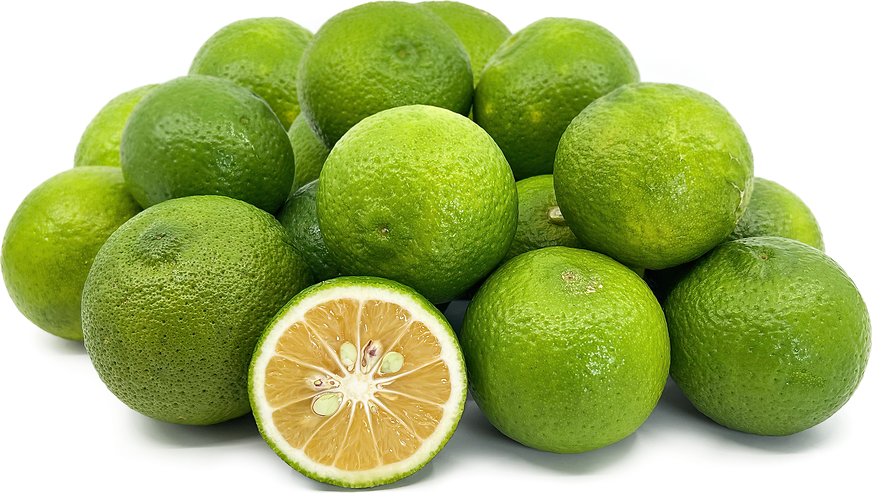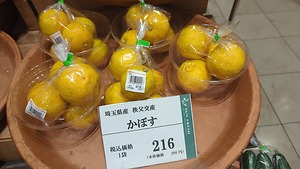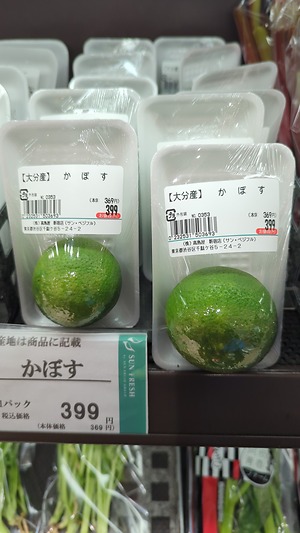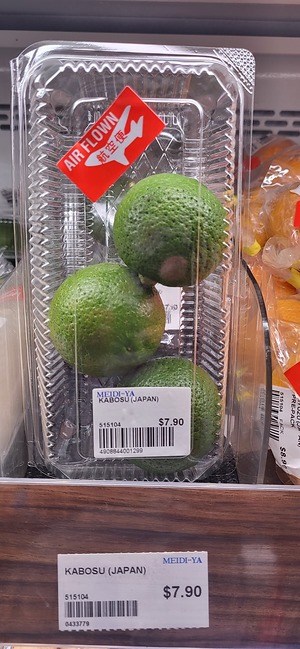


Kabosu Citrus
Estimated Inventory, lb : 0
Description/Taste
Kabosu is a small citrus varietal, averaging 4 to 5 centimeters in diameter, and has a round to ovate shape with a distinct bump protruding at the apex. The rind is relatively smooth, glossy, and pebbled, lightly textured with prominent oil glands. The rind also ripens from green to bright yellow with maturity. Underneath the surface, there is a semi-thin, white pith encasing 10 to 12 segments of aqueous, soft, and tender flesh. The pale-yellow flesh also contains many small, ivory to green seeds and emits a perfumed, sweet, and refreshing, citrus-forward fragrance. Kabosu citrus can be used in its immature green phase or mature, bright yellow state. The flesh is acidic, tart, and subtly sweet, slightly less sour and floral than yuzu, and carries notes of mint, lemons, and melons.
Seasons/Availability
Kabosu citrus is available in the fall in Japan.
Current Facts
Kabosu, botanically classified as Citrus sphaerocarpa, is a rare citrus variety belonging to the Rutaceae family. The aromatic tart fruits grow on evergreen trees and are a type of kosan kankitsu or Japanese sour citrus. There are over forty known sour citrus varieties regionally grown throughout Japan, and the cultivars are used to enhance the flavor in culinary preparations. Kabosu is closely related to the famous citrus yuzu and is utilized similarly to flavor sauces, juices, seafood, and main dishes. The fruits can be used in their unripe or mature stages and is a specialty type of sour citrus produced in limited quantities in the Oita Prefecture. Kabosu citrus is also valued as a home garden variety, highly ornamental for its delicate, fragrant flowers and brightly colored fruits, and the rind is used as a natural air freshener and mosquito repellent.
Nutritional Value
Kabosu citrus is a good source of vitamin C to protect the body against free radical damage, strengthen the immune system, and reduce inflammation. The citrus also provides potassium to balance fluid levels within the body, folate to develop genetic material, and other nutrients to cleanse the liver and stabilize blood pressure. In addition to vitamins and minerals, the fruits contain malic acid, citric acid, and essentials oils.
Applications
Kabosu citrus is known for its acidic juice, customarily used as a flavoring in both raw and cooked preparations. The citrus is traditionally washed, sliced in half, and squeezed with the skin side down to combine the essential oils in the rind with the juice. The fruit’s sharp juice is used as a substitute for vinegar and is mixed into sauces, dressings, and marinades to create a bright, sour taste. The juice can also be incorporated into soups and curries, noodle-based dishes, and used to flavor hot pot. In Japan, Kabosu citrus is popularly used to reduce the marine-like flavor in fish and is often served over sashimi and other seafood. It is also incorporated into ponzu sauce, infused into marmalades, candies, pastries, and ice cream, or used to flavor sodas, sparkling beverages, and cocktails. Kabosu citrus pairs well with aromatics such as ginger, garlic, and shallots, green tea, herbs including mint, coriander, and basil, meats such as poultry, pork, and beef, seafood including scallops, shrimp, crab, and fish, and fruits such as pomegranates, raspberries, peaches, cherries, and nectarines. When preparing Kabosu, the citrus should be massaged before slicing to soften the fibers within the flesh for easier juicing. The citrus can also be briefly heated in the microwave. Whole, unwashed Kabosu citrus will keep 1 to 2 weeks when stored in the refrigerator's crisper drawer.
Ethnic/Cultural Info
Kabosu citrus is a specialty product of the Oita Prefecture on the island of Kyushu in Japan. Within the region, the fruits are widely found at local markets and are used as a flavoring, but outside of Oita, Kabosu citrus is rare and challenging to find. In 2003, a mascot was designed to help market Kabosu to other regions of Japan. The mascot was named Kabotan, and the animated character is a Kabosu citrus drawn with a green circular head and body featuring human characteristics such as hands, feet, and a heart. Kabotan is often found on packaging, signs, and social media posts for the citrus variety, and a life-size Kabotan character also walks around festivals and events to take photos with attendees. In addition to its appearance, Kabotan has a character story centered around promoting the Oita Prefecture, including the mascot’s love of hot springs, famous in the region. Beyond marketing, Kabosu citrus enhances the subtle flavor of blowfish and yellowtail, delicacies in the Oita Prefecture. In 2010, farm-raised yellowtail grown in the Bungo Channel was established to create a new seafood sector. The fish were fed with ground Kabosu citrus to create a refreshing, citrus-like flavor within the flesh. Kabosu-infused fish are known as Kabosu-buri and are increasing in demand for their unique flavoring across Japan.
Geography/History
Kabosu citrus was discovered growing as a chance seedling in China during ancient times. While the exact date of origin is unknown, experts believe the variety may have been developed from a natural cross between a sour or bitter orange and yuzu citrus. Sometime during the Edo period, Kabosu citrus was introduced to Japan, and legend has it that a doctor from Kyoto named Shugen obtained the citrus from a monk during his studies in China and planted the first Kabosu tree in the Oita Prefecture, a region along the northeastern coast of Kyushu island. Kabosu citrus has been growing in Japan for over 300 years, and over ninety percent of the Kabosu citrus is produced in Oita, specifically in the areas of Usuki and Taketa. The original Kabosu tree was identified and nationally protected in 1976 in a private garden, but the tree eventually died in 1987, solely leaving behind a portion of the trunk. Today Kabosu citrus is mainly cultivated in the Oita Prefecture, and 200-year-old trees can still produce seasonal fruits. Outside of the prefecture, the citrus is considered a rare variety, occasionally found through local fresh markets in Japan. The cultivar is also grown as specialty citrus in home gardens and small farms in China and the United States.
Recipe Ideas
Recipes that include Kabosu Citrus. One










